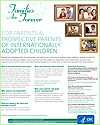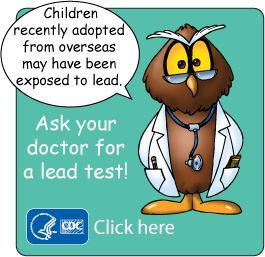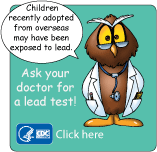International Adoption and Prevention of Lead Poisoning
Prospective parents adopting a child from overseas need information to safeguard the health of the child. This webpage contains information for adopting parents, adoption agencies, and health care providers.
The U.S. Department of State records show that from October 1, 2008, to September 30, 2009, a total of 12,753 internationally adopted children immigrated to the United States. The largest numbers of these children were originally from Ethiopia, mainland China, South Korea, and Russia. The risk for lead exposure is much higher in many countries from which children are adopted than in the United States (1, 2, 3). Each country sets its own policies on regulations for environmental exposures, and some countries have stronger regulations than others.
Main sources of exposure to lead differ from country to country
Children’s exposure to sources of lead varies by country (1, 2, 3). Even within a country, lead exposure may vary by ethnic group or income level. In the United States, lead-based paint and lead-contaminated dust and soil are the primary sources of high-dose childhood-lead exposure.
Children from outside the United States can be exposed to lead from
- Ceramic or metal dishes or pots used for cooking or eating,
- Contamination from living with a person who is exposed on the job,
- Contamination from nearby mining and smelting,
- Cosmetics,
- Cottage industries (e.g., breaking up batteries or metal ore),
- Drinking water from metal pipes or metal storage containers
- Food, spices, and candies (from the ingredients or the packaging),
- Industrial emissions, and
- Traditional medicines.
To read publications on country-specific sources of lead, visit
Risk for elevated blood lead levels
No safe blood lead level for children has been found. Because lead poisoning often occurs with no obvious symptoms, it frequently goes unrecognized. The level of blood lead that is currently considered high is a concentration of 5 or more micrograms per deciliter of blood. Evidence exists that lead in the body, even at low levels, can cause health problems and affect a child’s behavior or how they learn in school (4, 5). At very high levels, in extreme cases, it can cause seizures or death.
Parents or Prospective Parents of Adopted Children
Parent Factsheet [PDF – 395 KB]
Important information for parents and prospective parents of internationally adopted children to safeguard the health of children.
Why should I be concerned?
Concern exists about children adopted from overseas who may have been exposed to lead before they came to the United States. Recently in the United States, a small number of internationally adopted children have been found to have high levels of lead in their bodies.
As a group, foreign-born adopted children tend to have higher levels of lead in their blood than children born in the United States (3). Children can be exposed to lead in different ways in various in countries (1, 2, 3).
How do I know if my child was exposed to lead?
Most children with elevated blood lead levels do not have any symptoms. The only way to know for sure is to have your child tested with a simple blood test.
How can I check for lead in my child?
Ask your child’s doctor to test your child for lead in their blood. You may want to contact your state or local Childhood Lead Poisoning Prevention Program.
Who can I contact for blood lead testing or other information about the health of my internationally adopted child?
You can contact either your doctor or your local health department if you have concerns about lead in your child’s blood or other health concerns.
Some doctors and medical clinics focus on the special issues of children who are born in or adopted from countries around the world. The American Academy of Pediatrics lists physicians who specialize [PDF – 53 KB] in the health care needs of children born outside the United States
International Adoption Agencies
Adoption agencies play an important role in increasing awareness of lead exposure among internationally adopted children. Under current regulations and routine practice, elevated blood lead levels among foreign-born children may not be detected.
Adopting parents lack information on the hazards of lead exposure that could help them improve their children’s growth, development, and prospects for the future.
It is important that adoption agencies provide lead-exposure fact sheets with health information, including information on accessible testing sites, to prospective parents.
Adoption agencies should also encourage adopting parents and doctors to test foreign-born children for lead exposure when they arrive in the United States.
Click here to access a flyer to share with parents [PDF – 750 KB].
Health Care Providers
International Childhood Lead Exposure
Children immigrating to the United States through international adoptions have health issues as diverse as the cultures into which they were born (6, 7). Although recent research is sparse, evidence suggests that a significant proportion of immigrant and adopted children have elevated blood lead levels. Risk for elevated blood lead levels varies by country of origin (1, 2, 3). According to one study, 40% of children from Cuba and Haiti, 37% from Asia, 27% from Vietnam and Africa, and 25% from the Near East had blood lead levels. Overall, approximately 11.3% of adopted foreign-born children have blood lead levels ≥10 micrograms per deciliter (1).
Medical Testing before Immigration to United States
Blood lead testing is not required before immigration to the United States. Before arrival in the United States, all immigrants are required to have a medical examination in their country of origin by a physician approved by the local U.S. embassy or consulate. This medical examination focuses primarily on detecting serious disabilities and contagious diseases.
Recommendations for Screening and Medical Management of Children with Elevated Blood Lead Levels
Screening for blood lead level is recommended upon arrival to the United States, and at 12 and 24 months of age. Physicians should follow their state and local guidelines on health screening of children living conditions that place them at a high risk for lead exposure. International adoptees are considered high risk for elevated blood lead levels (6, 7, 8). You can also contact the Childhood Lead Poisoning Prevention Program in your state for additional information.
Video: ‘Lead Poisoning Prevention among Internationally Adopted Children’
Educational Materials
 Parent Factsheet [PDF – 395 KB]
Parent Factsheet [PDF – 395 KB]Important information for parents and prospective parents of internationally adopted children to safeguard the health of children.

Leadbert the Licensed Contractor Bookmark [PDF – 696 KB]
Print this image and cut out at margins and keep as a reference to information on lead poisoning prevention.
Information for Parent and Adoption Listserv
Copy and paste the text below into an email to post on your parent listserv.
CDC recommends that all internationally adopted children have a blood lead test during their first medical examination in the United States. Internationally adopted children may have been exposed to lead in their country of birth. Even though the number of children being adopted with elevated blood lead levels is small, a blood lead test can tell adoptive parents if their child is at risk so they can take action to protect the child’s health.
Information on lead testing for internationally adopted children is important for
- Parents of children adopted within the last 3 months,
- Parents now going through the adoption process, and
- All future prospective adoptive parents.
The Centers for Disease Control and Prevention provides information on preventing lead poisoning in children who are adopted from outside the United States. This information can be found at http://www.cdc.gov/nceh/lead/tips/adoption.htm. This site has important information on lead poisoning prevention that you should know to safeguard the health of your family.
Web Buttons
Copy the code: Dr. Hoot N. Owl button (large) (265×257):
<a href=”https://www.cdc.gov/nceh/lead/tips/adoptionflyer.pdf” title=”Children recently adopted from overseas may have been
exposed to lead. Ask your doctor for a lead test! Click here…”><img
src=”https://www.cdc.gov/images/campaigns/leadpoisoning/overseasadoptions_265x257.gif” style=”width:265px; height:257px;
border:0px;” alt=”Children recently adopted from overseas may have been exposed to lead. Ask your doctor for a lead test! Click
here…” /></a>
Copy the code: Dr. Hoot N. Owl button (small) (157×152):
<a href=”https://www.cdc.gov/nceh/lead/tips/adoptionflyer.pdf” title=”Children recently adopted from overseas may have been
exposed to lead. Ask your doctor for a lead test! Click here…”><img
src=”https://www.cdc.gov/images/campaigns/leadpoisoning/overseasadoptions_157x152.gif” style=”width:157px; height:152px;
border:0px;” alt=”Children recently adopted from overseas may have been exposed to lead. Ask your doctor for a lead test! Click
here…” /></a> Top of Page
Additional Resources
International Adoption: Health Guidance and the Immigration Process
Information forparents, adoption providers, and clinicians about international adoption.
Child Welfare Information Gateway: Intercountry Adoption
The Child Welfare Information Gateway is a service of the Children’s Bureau, Adminstration for Children and Families, U.S. Department of Health and Human Services.
U.S. Department of State: Intercountry Adoption [PDF – 1.11 MB]
This site provides information and guidance to U.S. citizens seeking information about international adoptions.
U.S. Bureau of Citizenship and Immigration Services [PDF – 1.36 MB]
This site provides information on intercountry adoptions and the immigration process.
Joint Council on International Children’s Services (JCICS)
JCICS is a nonprofit international adoption organization that works to promote ethical practices in intercountry adoption. This site provides information relevant to international adoption agencies, community-based organizations, parent support groups, and medical clinics.
Citations
(1) CDC. Elevated blood lead levels among internationally adopted children – United States, 1998. MMWR. 2000;49(5):97-100.
(2) Geltman PL, Brown MJ, Cochran J. Lead poisoning among refugee children resettled in Massachusetts, 1995 to 1999. Pediatrics. 2001;108(1):158-162.
(3) Parisa T, Leighton J, Auchincloss AH, Faciano A, Alper H, Paykin A, et al. Immigration and risk of childhood lead poisoning: findings from a case–control study of New York City children. Am J Public Health. 2008;98(1):92-97
(4) CDC. Healthy Homes and Lead Poisoning Prevention Branch website (https://www.cdc.gov/nceh/lead/).
(5) Canfield RL, Henderson CR, Cory-Slechta DA, Cox C, Jusko TA, Lanphear BP. Intellectual impairment in children with blood lead concentrations below 10 µg per deciliter. N Engl J Med. 2003;348:1517–1526.
(6) Hellerstedt WL, Madsen NJ, Gunnar MR, Grotevant HD, Lee RM, Johnson DE. The international adoption project: population-based surveillance of Minnesota parents who adopted children internationally. Matern Child Health J. 2008;12(2):162-171.
(7) Jenista JA. The immigrant, refugee, or internationally adopted child. Pediatr Rev. 2001;22(12):419-429.
(8) CDC. Recommendations for blood lead screening of Medicaid-eligible children aged 1–5 years: an updated approach to targeting a group at high risk. MMWR. 2009;58(RR09):1-11.
- Page last reviewed: June 15, 2013
- Page last updated: July 26, 2017
- Content source:
National Center for Environmental Health, Division of Emergency and Environmental Health Services


 ShareCompartir
ShareCompartir


